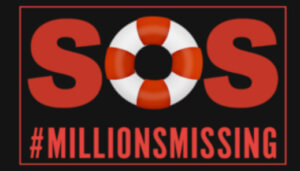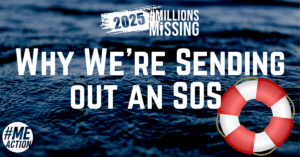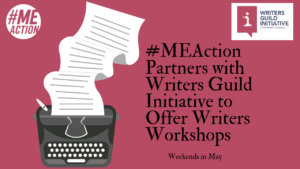Listen to the article:
Here is a question for you: Is your life small or large?
How do you know?
Is it possible to have a big life in a single, small room?
Or to lead a small life that is lived in many places?
They surface when I’m somewhere in between, too. When I’m in the living room of the house that I live in, a place I visit so infrequently that it seems like another country, taking a wheelchair ride to the shower or bath. At times like these, I may suddenly think, “My God—my world must seem to others so small—so sad!” But then that question bounces against a bigger and deeper feeling inside: “But my life doesn’t feel small or sad to me. Why is that?”
Perhaps I should explain a little about myself.

When I was twenty-five, I was enrolled in college at the University of Maine in Orono after concluding several years of traveling across the United States. I was studying to be an ecologist, I worked as a research assistant, and I was unhappy. At the time, I was engaged with a scientific field I no longer cared about in hopes of becoming someone I thought I ought to be—a proper scientist, not an artist who would never make much money. I wasn’t so much blossoming into adulthood as I was wilting. Life kept propelling me forward, rootless and unwilling, toward some future I could not conceive of and did not desire.
Perhaps that unhappiness was why I missed the first symptoms of my illness. Or perhaps it was simply because no one expects this to happen to them, this creeping and insidious sickness that hides the shadows, barely seen, until it’s already made itself at home in your life.
However insensitive I was to the signs, I took notice when one day, after an ordinary afternoon of classes, I was too tired to walk across the campus lawn back to my car.
What would you do in such a situation? It certainly feels like an emergency, but you cannot call 911. You need help, but no one will understand.
I had no diagnosis yet to explain my symptoms. I had no idea what was happening to me.

I can’t remember how long it took to get back to the car, but I can tell you that in the days that followed, I made sure to park as close as possible to each of my classes, and each day I got a parking ticket for my… creative parking choices. The last thing I did before I left university was pay my extensive parking bill. Then I went home and went to bed for a week.
That was six years ago. That day on the campus marked the end of an era when I was able to walk and bike and study without crushing fatigue waiting around the corner.
After college, I did well for a few months before again growing sicker and more profoundly fatigued. Whereas not long ago I had been unable to imagine my life’s path, now I was not sure I would have one at all. Eventually, I was forced to spend all day in bed, resting enough so that I could at least have the energy to prepare microwaved meals and make it to the bathroom. If I exerted myself, I paid for it afterward with drastically increased symptoms.
It was a dark time, both literally and figuratively. My illness caused me to be fatigued by bright lights, so I lay engulfed in the darkness of my bedroom. Sometimes I wondered at what point it would become sensible to end my own life. Could I endure fifty more years of this? It was unimaginable.
But sometime during this period, I also decided to start painting again. This desire came from a very different place than my other choices over the last few years. I didn’t do it because I thought I should, or because I might someday be successful. I did it because I saw a video online of a little girl throwing paint and glitter in the air while wearing a tutu, and I thought, that looks like fun.

So I started dragging myself to a corner of my room where I’d set up a little studio and throwing some paint and glitter around. If there were any rules I could recall about making “real art,” I tossed them out. Paper, beads, and bits of clay on canvas? Sure! The only criteria for each painting was that it pleased me.
So I lay in darkness and researched and learned self-care, and I also painted when I was able to walk and sit up. Over the next few years, I would have many ups and downs and several remissions and relapses. Over time, I became more and more sure of what illness was afflicting me. Finally, I printed the diagnostic criteria from the CDC’s website and brought in to my doctor’s office. I left with my diagnosis.
What was confirmed that day was something I had suspected for a long time.
I have CFS/ME, also known as myalgic encephalomyelitis (or chronic fatigue syndrome in the United States), a complex multi-system disease with post-exertional malaise, or worsening of symptoms following exercise, as its hallmark trait. It also, in its severe form, causes sensory processing problems and sensitivity to light and sound, as well as a coterie of auxiliary symptoms like pain and dysautonomia.

Though scientists are working on understanding its biological basis, much about the illness was and is unknown. Some patients have no treatments that work for them. Some, sadly, succumb to the illness and pass away. CFS/ME is capable of creating levels of disability similar to late-stage AIDS infection or what a cancer patient might experience during chemo. Few doctors are well- educated on the illness; some are disparaging and dismissive.
As chronic illnesses go, this is not the one you want.
But it’s the one I got. And strangely, through years of suffering that peeled back my layers and laid me bare to myself, it also is the one that has helped to lead me to myself.
Today, I live what may seem like an abridged life. I mostly stay in a single room, where I lie in bed in a dim, climate-controlled space. I have a clever set-up with a rolling table that brings my art supplies to my fingertips so that I can paint while sitting or reclined in bed.
For minutes to an hour a day, I work on creating my mixed-media paintings in a style that arose from my early experimentations with texture and color. Sometimes I can work for a while; other times, sitting up makes me so fatigued and nauseated that I have to lie down immediately and leave it for another day.
My artwork explores far-flung ecosystems through textured abstract color fields, embroidery and metalwork. I paint deserts, marshes, prairies and oceans. A remembered outing to the Maine coast, a Louisiana creek bed or a Pacific Northwest rainforest can be refracted through multiple paintings. Through my art, I see and feel the earth’s energy, channeling the uproar and harmony of these remembered landscapes.
I also reflect on my college courses in ecology and geology, but I connect to them now through art rather than science. Geology is a particular love of mine. The earth is tremendously dynamic, yet most of its dynamism is expressed over eons rather than moments. Perhaps there’s something about that that resonates with me. Like a continent on a tectonic plate, I’m drifting toward my own future so slowly I hardly seem to move.
My artwork also explores my love of exploring abandoned buildings overrun with nature, with their multiple layers of peeling paint and graffiti. I rarely get out to explore abandoned spaces now, but I keep a catalogue of them in my head and on film. I have many photos of the places I’ve explored, from overgrown barns, to industrial sites and factories, to gas stations and quaint families homes, still packed with moldering 70s toys and ephemera. I’ve always been fascinated with spaces being reclaimed by nature and the spontaneous art formed by their multi-textured surfaces.

Lately, I’ve been exploring an even more specific sense of place in my paintings, naming them for particular locales that have impressed something of their own dynamic soul upon me. My current project is a diptych abstract interpretation of Otter Cliffs in Acadia National Park, Maine, where rock climbers dangle above a ceaselessly moving sea.
 In some ways, it is in the small “container” of my illness that I have been able to better connect with my expansive self as well as the expansive soul of the world itself, which had at least seemed to elude me previously. I realize now that the beauty and terror of the world was always here, being absorbed, being channeled through the living matrix that is myself—the universe in self-observation.
In some ways, it is in the small “container” of my illness that I have been able to better connect with my expansive self as well as the expansive soul of the world itself, which had at least seemed to elude me previously. I realize now that the beauty and terror of the world was always here, being absorbed, being channeled through the living matrix that is myself—the universe in self-observation.Sometimes I cannot answer the question of a whether I have a small or large life, or whether what has happened to me is bad or good, heartbreaking or transformative. I don’t believe that I have to. The story is writing itself, like the continents that drift, ceaselessly, across the skin of the planet. They are in no hurry but I believe they are excited to arrive, someday, to find out what it feels like to be a maker of mountains or new seas.
all images courtesy ©2018 Zeraph Dylan Moore






10 thoughts on “Living Deeply in Tiny Rooms”
What a pleasant article! I’m suffering right now, but I wanted to read more of this wonderful description of your world.. so I took breaks. I read it all eventually and I feel a kinship of finding wonder, peace and happiness from my own set of small things that others might not share… as we’re all amazingly individual.
I’m not going to get into the negatives of my current situation, but I fit your description of the time in your journey when you needed to remained in a bed in a darkened room.. very ill and getting up to lurch to the bathroom, then kitchen to microwave a TV dinner. Yet, as I apply heat and pressure to the group of muscles in spasm from hipbone to ear (said ear is resting near my shoulder to releive the neck pain) I was made happy in my heart, and the turmoil in my mind and body has been calmed and quited by images in my mind of your art and the overgrown, ruins of buildings you described so beautifully. Thank you.
Hi Maschelle!
Thanks so much for sharing your thoughts about my article. It means a lot to me to be able to reach out in this way, and connect us together in our tiny rooms
Best,
Dylan
Thanks for sharing! Love that you are able to still paint and love your piece. I can relate so some of your descriptions
I also really enjoyed your post!
I love you’re quote “As chronic illnesses go, this is not the one you want.”
I’m an ex nurse, and in 1994 we had a new patient with ME. The Drs were doing their rounds, and I stood at the end of the corridor listening to them joke about her outside her room. I knew the. This wasn’t the illness I ever wanted, but like you, it’s the one I got!
I know it’s possible to be happy within my four walls, and mostly I am, but I need more!
I’m not the artistic type but there are some projects I’d like to do! We had just cleared out our cabin to make it into a crafts area but Ive now relapsed and I’m not sure I’ll make it out there! So maybe I’ll just have to bring it to me in my bedroom! So, thank you for your inspirational words which are incredibly encouraging. And I love your art!
Hi Fiona Thanks so much for your comment.
Thanks so much for your comment. But lately I’ve been getting so comfortable working in bed with my rolling overbed table that I think I actually prefer it! It’s been a process of getting all the things I need to work comfortably, and finally I have them.
But lately I’ve been getting so comfortable working in bed with my rolling overbed table that I think I actually prefer it! It’s been a process of getting all the things I need to work comfortably, and finally I have them.
Sometimes I wish for a studio, too! I can imagine exactly what it would look like, and how great it would be to post shots of my studio on Instagram
I’m going to make a post about my disability adaptations for art-making on my blog (http://www.grind-studio.com/blog) soon. I’d love to hear what you think, and how you end up adapting your space to make art – it is massively inspiring to me, as well!
Best,
Dylan
“Sometimes I cannot answer the question of a whether I have a small or large life, or whether what has happened to me is bad or good, heartbreaking or transformative.” Yes. This, exactly. Thanks for your beautiful words and sharing your story!
Thank you for sharing your experience so eloquently. I relate intimately with many aspects of your life, for they are similar to mine. I still rail (after 32 years) at the limitations this illness continues to put on my experience – even the limits it puts on the ways I can even describe or be conscious of my experience. I was an actress – very little chance of accommodating that way of life into the limitations I have experienced for so long. I am, however, a writer of sorts, and I try, mostly unsuccessfully to channel my energies there. And amazingly I happened upon a chance to be a theater reviewer for an indie weekly newspaper. I have done that a number of years, but I’m beginning to believe that even that might now be too much. Words, judgments, ideas about what makes a life are all relative. Perhaps the most we can hope for, for those of us saddled with the challenges we endure, is that our creative natures allow us to fashion lives we can embrace and that lead us ever into a new consciousness of how we, though limited, are worthy of the time on the planet we are given.
Thank you for your beautiful article. Wishing you greater health and love.
Thank you for casting light into our dark world. You write and describe our situation brilliantly. I am so pleased that you have found yourself. So many describe this as the worst and best thing that has ever happened to them. I guess when everything it’s stripped away we hold on tightest to what’s important. You are inspiring.
Angela – I appreciate your comment about things/people/activiites being stripped away and then holding tight to what’s important. This is a succinct comment about what is actually a very lengthy process, and one that is continuously being revised.. We have to acknowledge and grieve individually for every lost thing, and we have to work mightily to find what is important to hold on too. At my age (67) there are more, new losses than I have experienced before. As I find myself needing to withdraw more and more into my home, I’m looking at the substance of my life as almost a spiritual practice, this losing and grieving and trying to find what to hold to. It’s sort of like being a monk, sequestered and often silent, sitting with what is and what is not, hoping for the power to let go and to discover a new consciousness and sense of being.
Comments are closed.